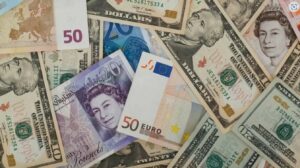Despite the reputation of the foreign exchange market as a banker’s game, currencies can occasionally be a terrific method to diversify a portfolio that has perhaps struck a bit of a rut. This market has the potential to present enormous opportunities when other international fora experience a slump.
Therefore, having a basic understanding of forex and the underlying principles can be a useful addition to the toolkit of any trader, investor, or portfolio manager. Let’s examine eight currencies, along with the relevant central banks of each country, that any trader or investor should be familiar with.
USD
The Federal Reserve System, usually known as the Fed, was established in 1913 by the Federal Reserve Act and serves as the nation’s central bank.
The Federal Open Market Committee (FOMC), a branch of the system that is led by a chair and board of governors, receives the majority of attention. The FOMC oversees interest rates, monetary policy, and open market activities.
Five of the twelve current Federal Reserve Bank presidents are represented on the committee, together with seven other members of the Federal Reserve Board. The president of the Federal Reserve Bank of New York always serves on the group. The committee meets every six weeks, and although there are only 12 voting members, non-members, including extra Fed Bank presidents, are welcome to speak about the state of the economy.
(EUR) European currency
The European Central Bank, which has its headquarters in Frankfurt, Germany, serves as the central bank for the 19 eurozone members.
Similar to the FOMC, the ECB has an Executive Board that consists of four members including a president and vice-president, and is in charge of deciding on monetary policy.
The five largest economies in the system Germany, France, Italy, Spain, and the Netherlands reserve four of the seats for themselves for choosing the policy-making ECB officials. This is to guarantee that, in the event of a change in administration, the major economies are always represented. Nearly weekly board meetings are held.
The ECB has the authority to set monetary policy in addition to issuing banknotes as it sees proper. Policymakers have the same intervention power as the Federal Reserve during bank or system failures.
The ECB is fundamentally different from the Fed in that it prioritizes price stability over general economic policies, with secondary commitments to both. The Fed aims to maximize employment and ensure the stability of long-term interest rates.
As a result, when deciding on the appropriate interest rate, authorities will pay close attention to consumer inflation.
The money is simple, despite the complexity of the monetary system. The euro (EUR) often moves more slowly against the U.S. dollar than its counterparts, such as the British pound or the Australian dollar. The base currency can fluctuate between 70 and 80 pips, or percentages in points, on a typical day, with wider swings, which are more volatile, averaging 100 pips every day on average.
British Pound (GBP)
The Bank of England acts as the monetary counterpart of the Federal Reserve System as the country’s central bank.
Similar to the Court of Directors, which is a governing body chosen by the Crown and composed of five executive members and up to nine others, including the chair and deputy chair, is the Court of Directors.
Additionally, there is a Monetary Policy Committee (MPC), which consists of nine members, four of whom are chosen by the Chancellor of the Exchequer, and is presided over by the governor of the bank. The MPC makes decisions about interest rates and broader monetary policy at least eight times a year, focusing primarily on the economy’s overall price stability.
As a result, the MPC also uses 2% as its baseline for consumer price inflation. The governor is required to send a letter to the Chancellor of Exchequer notifying him or her if this criterion is violated; one such letter was sent in 2007 by the U.K. CPI (Consumer Price Index) increased significantly to 3.1%.
Since it enhances the likelihood of contractionary monetary policy, the publishing of this letter frequently signals market activity.
CAD (Canadian Dollar)
The Bank of Canada is the central bank mandated to concentrate on the objectives of low and stable inflation, a safe and secure currency, financial stability, and the effective management of government funds and public debt. It was established by the Bank of Canada Act of 1934.
Because it occasionally operates independently, like a corporation with the minister of finance holding shares directly, Canada’s central bank is comparable to the Swiss National Bank.
Despite the closeness to the government’s interests, the governor must advance price stability independently of the current administration while also taking the government’s worries into account. With a 2% inflation target, the BoC has a history of remaining slightly more hawkish than accommodating when it comes to price fluctuations.
The Canadian dollar (CAD), commonly known as the loonie, typically trades in daily ranges of 50 to 100 pip, keeping pace with other major currencies.
Numerous commodities and currency prices move in tandem, and the CAD’s association with crude oil is special. As a result of the nation’s continued prominence as a producer of the commodity, many traders and investors utilize this currency either as a pure hedge against their current commodity positions or as pure speculation, following signals from the oil market.
Swiss Franc (CHF)
The Swiss National Bank is seen as a governing entity with private and public ownership, in contrast to all other significant central banks. This notion is based on the Swiss National Bank’s legal status as a business subject to particular laws. As a result, the sovereign cantons or states of Switzerland and other public institutions possess somewhat more than half of the governing body.
This arrangement highlights the SNB’s governing board’s directives for economic and financial stability. Monetary policy decisions are made by three main bank CEOs who meet every quarter, making them smaller than other governing organizations.
The range (plus or minus 50 basis points) within which the interest rate will fall is established by the Governing Board.
The link between the Euro and the Swiss franc is intriguing. The Swiss franc (CHF), like the euro, rarely changes much over any given session. As a result, anticipate that this particular currency will fluctuate within a range of 45 pip per day on average. For this currency, high-frequency trading is typically reserved for the London session (3 a.m. to noon EST).
JPY, Japanese Yen
The Bank of Japan, which was founded in 1882, is the central bank of the third-largest economy in the world. It oversees monetary policy as well as currency issuance, money market activities, and data/economic research.
While continually exchanging ideas with the current administration and working toward its independence and transparency, the primary monetary Policy Board tends to promote economic stability.
The governor oversees a team of nine policymakers, including two appointed deputy governors, who meet to discuss monetary policy eight times a year.
The Japanese yen (JPY) frequently trades as a component of carry trades.
The currency competes with higher-yielding ones, such as the British pound, Australian and New Zealand dollars, and New Zealand and New Zealand dollars, by offering a low-interest rate.
Due to the underlying’s propensity for irrationality, FX traders are compelled to adopt longer-term technical viewpoints. Daily ranges range from 70 to 140 pip on average, with extremes far over 200 pip.
Focus on the overlap of London and U.S. hours (8 a.m. to noon EST) to trade this currency with some bite.
Australian and New Zealand dollars
The Reserve Bank of Australia has consistently defended price stability and economic strength as the cornerstones of its long-term plan, offering one of the highest interest rates in the major international markets. The bank’s board, which is presided over by the governor, is made up of six members-at-large, a deputy governor, and the secretary of the Treasury. They meet eleven times a year to discuss their shared goal of keeping inflation between 2% and 3%.
The Reserve Bank of New Zealand pursues inflation targeting similarly to support prices.
The Australian and New Zealand dollars (AUD and NZD), which are available on most platforms and offer the highest yields of the seven major currencies, have drawn carry traders’ attention to both currencies.
As a result, if a deleveraging effect occurs, volatility may be felt in these pairs. Otherwise, the average trading range for the currencies is often between 70 and 80 pips. Additionally, both currencies continue to have connections to several commodities, most notably silver, and gold.
Conclusion
Foreign exchange and currencies will play a bigger part in daily transactions as financial markets continue to develop and expand globally. The market sector’s notional volumes already average more than $6 trillion daily.
As a result, currencies continue to present greater options to both retail and institutional investors, whether it be a conversion for actual commerce or a straightforward portfolio diversification play.





